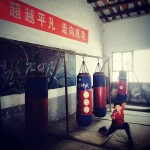
The last remaining gate of Hong Yan Temple, which housed the secrets of Emei Kungfu. There were once 48 gates, according to legend, and hundreds of monks.
I recently traveled to Emei, again, and to Shanghai to meet with a disciple of Chen-style Taijiquan, Chen Jia. There were some highlights that I will try and talk about below, but what these trips also did for me was help crystallize the framework for this story I am writing.
One thing that has come clear to me over the past few weeks (and years actually) is that 武术 is so deep and so broad that I have literally no hope of understanding a large portion of it unless I dedicated myself to a life of scholarly research – and I actually just imagined finding Ming Dynasty contemporary accounts of the training that mountain-bound monks did in preparation for battle with rebels, and I literally teared up. What a beautiful thing, an old text illuminated again … but I digress.
The Ruins of Emei
So I have spent a lot of time just thinking. I met Master Zhang again in Emei and I wanted to see the ruins of the Hong Yan Temple, the temple that supposedly held the secrets of Emei Kungfu until being burned to the ground during the Qing Conquest, and then again during the Cultural Revolution. Only a tiny gate remains from what was once a vast complex of temples that “required a horse to traverse”. That tiny gate leans at the edge of a basketball court, where kids from the Gaoqiao Middle School play every day. I asked one of the girls who ran out of the schoolhouse if she knew what the gate was and she said,
“Of course I do, it was a temple”
When I go into a pedantic speech about Emei Kungfu, her eyes glaze over and she tugs at the sleeve of her pubescent boyfriend and barks out, “Ok thank you! We’re going now!”
I can’t help but chuckle.
Later on Master Zhang takes me to meet another Master, a man who studied Jianxian Kungfu, so named due to that style’s tendency to spit out blades and cut necks (trees, Master Zhang told me) at 15-20 meters.
“I never believed all of the stories that people told about masters jumping from roof to roof, or floating, or using their qigong to make the water in a deep well rise up,” said Zhang. “But after I saw my friend’s master, I believed all of those things.”
On the way to meet this new master, Zhang and I discussed opening up a school in Emei to revive the old arts. I couldn’t help the sinking feeling in my stomach as Zhang put himself forward as the man to run the school. I had goaded him into it with my constant mentions of foreign students looking for masters, but somehow I wanted him to refuse.
We went to Emei No. 1 High School, where Zhang has taught P.E. for the past 20 years, and he told me that we were going to meet Master Deng now, of the Jianxian style. There were a dozen small food carts at the gate of his school and I wandered over to check out what they had to offer. I love food carts and small cities like Emei always have the good, greasy food. I ordered some fried potatoes and some tofu on a stick, when I saw a noodle cart enveloped in steam. The small bowls stacked up along the front of the cart were exactly my style: beef and mushrooms with pickled veggies. I walked up and began to order. Master Zhang appeared suddenly at my elbow and said, “this is Master Deng.”
Forgive me if I exulted inside like Po the Panda. A master hiding in a cloud of steam, selling noodles outside of a school, able to spit razors and grab coins from the bottom of a well using qi? We have ourselves a character for a RZA flic.
Nothing could live up to the vision that passed through my mind in the second it took for the steam to subside and for Master Deng to wipe his hands and come sit down next to us. I asked if I could take a picture, or record what he said, but he said no, maybe next time. He looked nothing like a master to me. Slightly overweight, balding, with bug-eyes that shifted in circles and starts as he described his master’s abilities. The same exact wording as Master Zhang’s on the ride over. Spitting razors. grabbing coins out of a well. Flying.
I felt like challenging him right then. Challenging them both … “If you two can whip my ass, then I will believe everything you say. If not, then I call you charlatan.”
But I didn’t challenge anyone. Not out of fear of my own well-being, but out of sympathy. Say I beat up this old man, who once studied a bit of kung fu with a real master 30 years ago. Now that he is selling noodles outside of a school, the last thing he needs is to have those memories placed in stark contrast to the life that grew out of them.
But I hold out hope. That Master Deng, with his shifty bug eyes and short, stubby fingers, is actually one of the Last Masters.
Kungfu Princess
I met a bona fide kung fu princess in Shanghai last week, while drinking cup after cup of oolong and pu’er tea at 优太极, a school teaching Chen-style taijiquan. Chen Jia is a Hunan girl, short and fair, with a lopsided grin and a crooked nose that only accentuates the je ne sais pa that made me develop a slight crush on her as she re-traced her steps from the school she runs back to her youth stretching and kicking bags with her dad.
She is what we could call a 江湖人, a “river lake person” … someone who travels far and wide, sometimes with a goal and sometimes not, with just the clothes on their back and maybe a momento or two. Any good kung fu story has a river lake person or three. Chen Jia’s travels did have a goal: to find a master. She left her home in Hunan and headed north first, to Beijing, and studied with masters there, learning a bit of 长腿 Long Leg or Northern Kicking Style kungfu. After a few years there she headed south again, to Shaolin, to see if the famous temple had something to offer.
She didn’t find the master she was looking for, so on a whim she took a side trip to the Chen Family Valley, where Chen-style 太极拳 originated … and there she found what she was looking for. A whole village of martial artists, practicing daily, learning from and teaching each other. Her kungfu background gained her access to the schools in the valley, and her dedication soon caught the eye of Chen Xiao Wang’s students and son. Chen Xiao Wang is widely considered to be the greatest practitioner of Chen-style taiji alive today. He is often abroad.
As she tells me this story, coaches and students come in and out of the school she runs in Shanghai. A few people call. Some come and listen reverently as she tells her story and the story of taiji in China. The story of her master and what she dreams of in the future. At several points throughout the interview, I want to reach out and hug her. Her enthusiasm is not quite bubbly, but infectious. Steely actually, and tempered by hours of practice each day. She could toss me across the room, or giggle at a joke, or listen intently, or sip tea quietly, or just sit there and smile.
She is a master, but in her own eyes she is a student, a young one, and just beginning her journey. A river lake kungfu princess with the wind at her back. I am smitten, and when she invites me and my family to Henan to visit the Chen Family Valley with her and her master next March, I laugh and nod, of course we’ll come.
(I know all of you want a picture, but I am purposely withholding what I have until … I don’t even know when … Build an image in your heads.)




Master Zhang looks formidable. Cool photo.
We’ll see what Master Deng can do next time. I am optimistic, but skeptical at the same time. As for the princess, she ain’t hot like a movie star, but I know you 10z, she’d have you dancing around her like a big fuzzy gorilla in no time.
Another good update! Keep us posted.
Loved this one!
The picture of that gate freaked me a little bit … seen it before. Spooky Qigong is at times.
Stay well my friend…